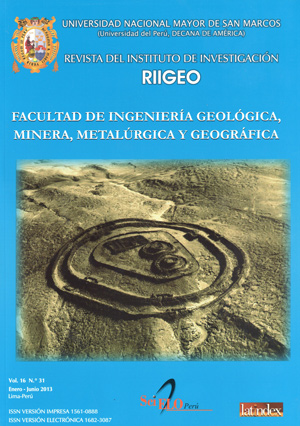Geological evidence at the Astronomical Chankillo complex (Casma, Ancash)
DOI:
https://doi.org/10.15381/iigeo.v16i31.11275Keywords:
Chankillo astronomical complex, Chankillo geology, Exploitation of boulders in ChankilloAbstract
Chankillo is an archaeological site with ceremonial, administrative and defensive aspects which also has a the oldest of America, 2400-year-old solar observatory. The geomorphology of the area occupied Chankillo consists of the following units: chains of hills, streams, reservoirs and valley wind. In terms of regional geology, the main unit is the Tonalita Huaricanga II Lower Cretaceous, which has been intruded by processes, granite dykes, pegmatites and later andesite dikes.
The main rocks used in construction were Chankillo tonalite; to a lesser extent granite and others. Their sources are mainly around the site. Several methods of exploitation was used for rock blocks, including in situ extraction wells, trenches, cut slope, and even pick up loose material. To remove the rocks, fracturing his hitting them naturally hard hammers and chisels and resistant rock preyed mainly andesitic volcanic rocks, whose supply was given from the Casma river boulders.
There breaking rocks until wedge-shaped artifacts. The extracted blocks have mostly smaller sizes 0.60 m, and have angular shapes. Once extracted, they were transported to the construction of buildings, where they were given further shape and are placed on the walls with mud mortar. Finally, it was completed with plaster based on clay, painting with ocher, brown, yellow and white.
Downloads
Published
Issue
Section
License
Copyright (c) 2013 Iván Ghezzi, Enrique Guadalupe Gómez

This work is licensed under a Creative Commons Attribution-NonCommercial-ShareAlike 4.0 International License.
AUTHORS RETAIN THEIR RIGHTS:
a. Authors retain their trade mark rights and patent, and also on any process or procedure described in the article.
b. Authors retain their right to share, copy, distribute, perform and publicly communicate their article (eg, to place their article in an institutional repository or publish it in a book), with an acknowledgment of its initial publication in the Rev. Inst. investig. Fac. minas metal cienc. geogr.
c. Authors retain theirs right to make a subsequent publication of their work, to use the article or any part thereof (eg a compilation of his papers, lecture notes, thesis, or a book), always indicating the source of publication (the originator of the work, journal, volume, number and date).






